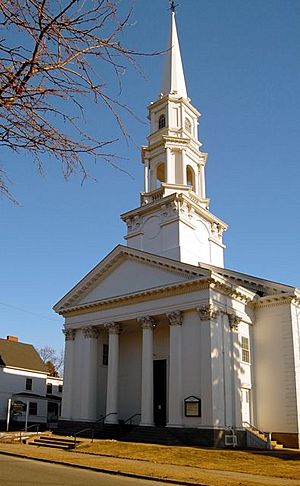Bradford, Massachusetts facts for kids
Quick facts for kids
Bradford, Massachusetts
|
|
|---|---|

Bradford's First Church of Christ, facing the common
|
|
| Country | United States |
| State | Massachusetts |
| County | Essex |
| Incorporated | January 7, 1672 |
| Disincorporated (Annexed) | January 1, 1897 |
| Time zone | UTC-5 (Eastern) |
| • Summer (DST) | Eastern |
Bradford is a historic village in Essex County, Massachusetts, USA. It used to be a separate town. Today, the eastern part of old Bradford is the town of Groveland. The western part is now a neighborhood of the city of Haverhill, located on the south side of the Merrimack River. Even though Bradford is no longer a separate town, its name lives on in many places around the area.
Contents
History of Bradford
Bradford was first settled by Europeans as part of the town of Rowley. It was known by names like "Rowley on the Merrimack." On January 7, 1672, the community officially changed its name to Bradford. This new name honored the town of Bradford in England, where some of the first settlers came from.
The first church, or meeting house, in Bradford was built where the Old Bradford Burying Ground is today. This building was replaced several times over the years. In 1726, the eastern part of Bradford became its own church parish. This area later became the town of Groveland in 1850.
Bradford also played a role in early American conflicts. In 1676, during King Philips War, a settler named Thomas Kimball was killed. Later, during the French and Indian War in 1755, Captain William Kimbal led a group of men from Bradford to New York. During the American Revolution, Captain Nathaniel Gage led 40 men from Bradford to the Battle of Bunker Hill in 1775.
The first school in Bradford opened in 1701. By 1820, there were seven schoolhouses in the area. A famous school, Bradford Academy, was founded in 1803. A railroad line reached Bradford in 1837, connecting it to other towns.
The population of Bradford grew steadily over the years. In 1765, about 1,125 people lived there. By 1840, the population had more than doubled to 2,222. After Groveland became a separate town in 1850, Bradford's population was 1,328. Just before it joined Haverhill in 1897, Bradford had 4,736 residents.
| Historical population | ||
|---|---|---|
| Year | Pop. | ±% |
| 1765 | 1,125 | — |
| 1776 | 1,240 | +10.2% |
| 1790 | 1,371 | +10.6% |
| 1800 | 1,420 | +3.6% |
| 1810 | 1,360 | −4.2% |
| 1820 | 1,600 | +17.6% |
| 1830 | 1,856 | +16.0% |
| 1840 | 2,222 | +19.7% |
| 1850 | 1,328 | −40.2% |
| 1860 | 1,687 | +27.0% |
| 1870 | 2,014 | +19.4% |
| 1880 | — | |
| 1890 | — | |
| 1895 | 4,736 | — |
| 2014 | 13,416 | +183.3% |
| * = population estimate. Source: United States Census records and Population Estimates Program data. Source: |
||
Why Bradford Joined Haverhill
Bradford is located just south of Haverhill, across the Merrimack River. In 1850, the eastern part of Bradford became the separate town of Groveland. Later, in 1870, Haverhill became a city. People in both towns started talking about Bradford joining Haverhill.
In 1896, residents in both Bradford and Haverhill voted to approve the idea. So, on January 1, 1897, Bradford officially became part of the City of Haverhill.
There were several reasons for this change. Some Bradford residents had businesses in Haverhill and hoped for lower taxes. Also, Bradford did not have as many public services as Haverhill, such as hospitals and larger schools. Joining Haverhill meant Bradford residents could use these services more easily.
Bradford was mostly a farming community for a long time. While most farms are gone, a few still operate today. There were also several shoe factories in Bradford. Many mills operated along Johnson's Creek, including mills for processing wool, cutting wood, and grinding corn.
Education in Bradford
Bradford has been home to several schools and colleges over the years.
- Bradford College (now closed)
- Bradford Christian Academy
- Northpoint Bible College
- Carleton School
- Caleb Dustin Hunking Middle School
- Bradford Elementary School
- Sacred Hearts School
- Greenleaf Elementary School
- Knipe Elementary School (now closed, building is now Bradford Christian Academy)
- Haverhill High School (located across the Merrimack River in Haverhill)
Notable People from Bradford
Many interesting people have connections to Bradford:
- Dick Blaisdell – A baseball player.
- John F. Boynton – An early leader in a religious movement, also a geologist and inventor.
- Isaac N. Carleton – An educator who founded Bradford's Carleton School.
- Walter Tenney Carleton – A businessman and one of the founding directors of NEC Corporation.
- William Cogswell – A U.S. Representative and a colonel in the Union Army during the American Civil War.
- Ann Hasseltine Judson – Known as America's first female missionary to serve overseas.
- George Davis Snell – A scientist who shared the 1980 Nobel Prize in Physiology or Medicine.
- Rob Zombie – A famous American singer, songwriter, and filmmaker.



